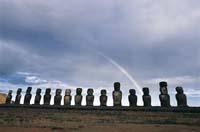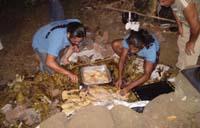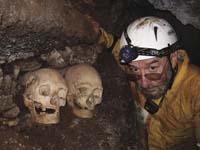Rapa in Nui, in the caves of the navel of the world
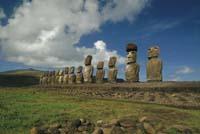
Thanks to the Council of Elders of Rapa Nui and the Government of Chile, the members of the Association of Speleological Sciences Alfonso Antxia of Bilbao have worked for four years in the area roiho of the island of Rapa Nui. With the help of researchers from the universities of Almería, Chile, Bologna, Trieste, Madrid and Navarre, we have studied the volcanic tubes of the area and have worked different scientific branches to deepen their traces and their culture.
Island of volcanic origin
The island of Rapa Nui, located 3,800 kilometers from the Chilean coast, in the Pacific Ocean, is the most isolated and populated island. In a radius of 2.000 kilometers no one lives. The island is characterized by its small extension (16.5 km long and 17.5 km wide), its subtropical climate (between 18 and 25 degrees) and its high annual precipitation (1000 mm or more). The island was formed thanks to the eruptions of three volcanoes (Terevaka, Rano Kau and Poike) and the highest point of the island is 500 m.
The island of Rapa Nui is of volcanic origin. And the caves of the volcanic islands are called volcanic tubes. They are structures formed by lava that are usually formed in lands with little slope. When in the eruptions the flood of lava dries quickly on the surface, on the outside there is a hard layer, but the inner lava continues to move, forming some pipes of hundreds of meters and others of a meter of diameter. Once the pipe dries, if the top layer falls, a structure called jameo or "mouth" is created that allows speleologists to access the cave.
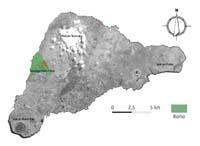
Volcanic tubes of the area of Roiho
Roiho is the area chosen to work and the one that has more volcanic tubes, since in it are found most of the thousand caves censored in Rapa Nuin. That's why we choose this area. It has an area of 4 km 2 and is a volcanic series from the volcanic cone Maunga Hiva Hiva, in Maunga Terevaka (Terevaka volcano). It is a very dry and uncomfortable place to walk through its volcanic rocks. Roiho is a volcanic series formed in the last eruption of the island of Easter about 10,000 years ago.
The volcanic tubes of Roiho are filled with narrow caves. The access mouths to the interior of the caves (jameos) are dispersed along the volcanic series. Sometimes it is not easy to find jameos, since it is a large area of black and reddish rocks, free in the landscape. We had to do walks of many hours, on the caving material, looking for holes and introducing their references in the GPS. But on other occasions we look at the volcanic section and look very well, since from it the trees grow, and it is a sign that there is a hole in the bottom (the trees grow in those holes, since in the holes the humidity stays better). The volcanic tubes of Rapa Nui are located a few meters from its surface and it is easy to access the interior. Since the volcanic pipes of the area of Roiho, in general, are at the same level, we have not needed materials to work vertically, except in the coastal caves. Their access, sometimes, has been quite complicated, since the entrances to the caves give to the cliffs. However, the difficulty to study the tubes has been, above all, its narrowness and, in many cases, its collapse (that is, its filling of stones and mugs). For this reason, to perform the topography, we had to drag the main part of the cave system.
2005, 2007, As a result of the work carried out in 2008 and 2009 we have obtained interesting results with stays of one month each year.
Topographic work
An underground topography of 10 km of volcanic cave has been carried out. Of these it has been shown that 6,5 km. They constitute a single system of caves (system Ana Te Pahu - Ana Heva - Vaiteka), that is, the cave itself. Thus, we have seen that the area of Roiho de Rapa Nui is the 11th largest volcanic cave system in the world and the largest in Chile.
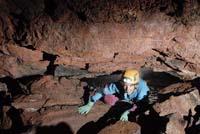
In addition, a hundred caves have been located in the topography, as well as geographical references of the caves analyzed. In addition, in the topography have been located caves with water or any type of evidence (anthropological, biological...), since a topography has been carried out in different layers. In this work we realized that in the entrances of all the caves that had water there were petroglyphs (figures carved in the rock). So we realized that the presence of petroglyphs was a sign that there was water in the caves. This discovery has been very interesting and the result was considered important.
Through the photographs we have been able to obtain information about the caves. On the one hand, the interior of the volcanic pipes. On the other hand, the anthropological remains found are: human bones, oidic arrow tips, knives and other utensils, mortars, kiea (paintings to color the body), petroglyphs, pictographs (rock paintings), etc. It is advisable to leave all these tracks in the place where they have been found, since one day you could investigate. However, if you move, the information would be lost. And finally, the speleothemes or structures that form in the caves, that is, stalactites, stalagmites and other structures.
Study and discovery of invertebrates
For the first time we have found the underground fauna of Rapa Nuin, in the cave of Ana Roiho, in the National Park of Easter Island. The invertebrates found in Ana Roiho have been analyzed by Rafael Jordana and Enrique Baquero, from the Department of Ecology and Zoology of the University of Navarra, finding new species. A new species described belongs to the group Collembola (Collembola, Entomobryomorpha, Entomobrydae) and has been called Coecobrya kennethi n. sp. Another species of this group has also appeared. On the other hand, there has also appeared a new species of the Sinella group that has not yet been called. Finally, the species Arrhopalites caecus has been cited on numerous occasions in the northern hemisphere, both in Australia and New Zealand, but has appeared for the first time on the island of Rapa Nui. In addition to these species, Dr. Moraza of the University of Navarra studies three types of mites (two Oribatida larvae and one Mesostigmata larva) found in the cave of Roiho. The discovery of these species is one of the contributions of our work to science and the island of Easter.
Discovery and analysis of speleotopics

Since we started studying the caves, we realized that the speleothemes or structures of the caves that we found there were very interesting. The formations in lava caves are, in general, irregular and of small size. In the cave of Rapa Nuiko Ana Hetereki, however, we saw new stalactites with a long and narrow structure of yellow colour. These unique structures (mucolytes) have been analyzed by Professor Paolo Forti of the University of Bologna and by Professor José María Calaforra of the University of Almería, and have seen that they have been formed thanks to the organic matter introduced from the outside. In addition, the fact of being formed by thousands of thin layers of microorganisms has shown that the mucolytes were on the island before the inhabitants who built the moai arrived.
Studies conducted under optical and electronic microscope have shown that these mucolytes are of biogenic origin and are constituted by live or dead diatomas of the Criminal Order and cyanounion. On the other hand, DNA studies were carried out with in situ hybridization technique (FISH and CARD-FIISH techniques) in the laboratory of Ricardo Amilsen, in the Center of Molecular Biology of the Autonomous University of Madrid. These studies show that mucolites are formed by a large number of living microorganisms, in which, in addition to diatoms and cyanobacteria, proteobacteria predominate (more specifically gammaproteobacterias). In other caves we have obtained similar results in mucolytes and fangos, which means that this type of microorganisms have had a great importance in the formation of mucolytes.
Physical-chemical analysis of water
In February 2008 and 2009, the physic-chemical studies of the waters of the caves of Rapa Nui were carried out using the field apparatus. In addition, the rainwater was sampled and analyzed (Hanga Roa capital).

In summary, the waters of the volcanic tubes of Rapa Nui are mostly chlorinated in sodium and/or magnesium. Due to the superiority of this profile, it can be concluded that water comes mostly from rainwater (there are no rivers on the island), since it has the same profile of chloride as this type of water. In addition, the composition of water from volcanic pipes includes rock components such as silica, iron and nitrates. When the rainwater that filters through the surface is inserted into the interior of the volcanic tubes and condenses as a thick drop on the walls of the cave, it increases the interior humidity, so the water accumulates in the interior of the cave. There are no big differences between caves and others. As for the type of water, the biggest difference is given in the water sample taken in the cave of Anakena, closer to the coast, with more conductivity and more chlorides, probably due to the marine spray. They are, in general, waters of low mineralization, of neutral pH, not saturated and of good quality in terms of physicochemical parameters (sodium, chloride, bicarbonate and nitrate).
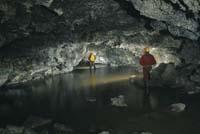
Latest references Latest references
The work carried out in the lava fields of Roiho has revealed the importance of the hundreds of caves that host, not only from the point of view of speleology, but also of the rest of sciences, such as bulcanospeleology, geology, biology and archaeology.
Finally, we would like to express our sincere thanks to the Council of Elders, Ariki, the Pakarati family, the Crown and the family, the Governorate of the island of Easter, the CONAF, the CONAD, the Committee of National Monuments and all the people who have made this work possible.
Maururu Choir! Yorana!
Linguistic advisors: Agurtzane Urrutia/Imanol Miranda.
Iñakiri, Arani, Asierri
Aku Akua of my heart, in memory, with love
Naufrago I was, before navigator Séneca
BIBLIOGRAPHY BIBLIOGRAPHY
